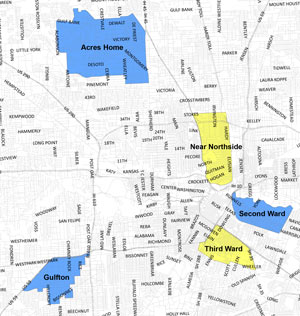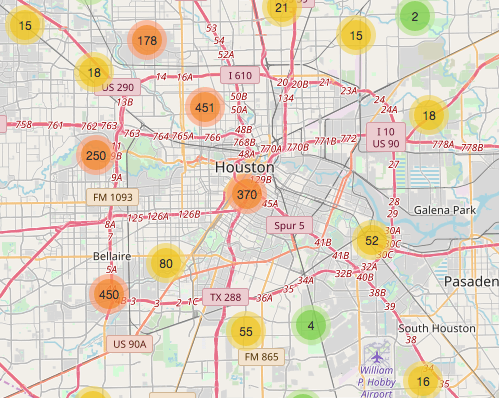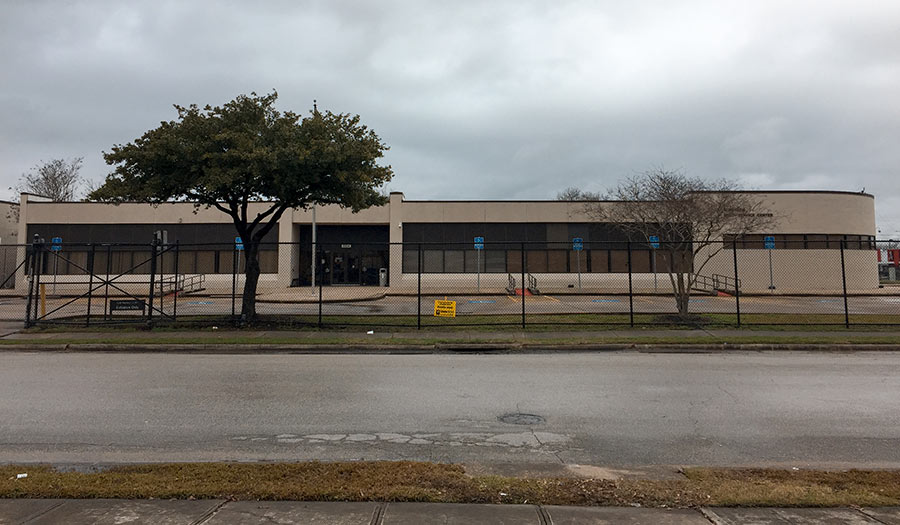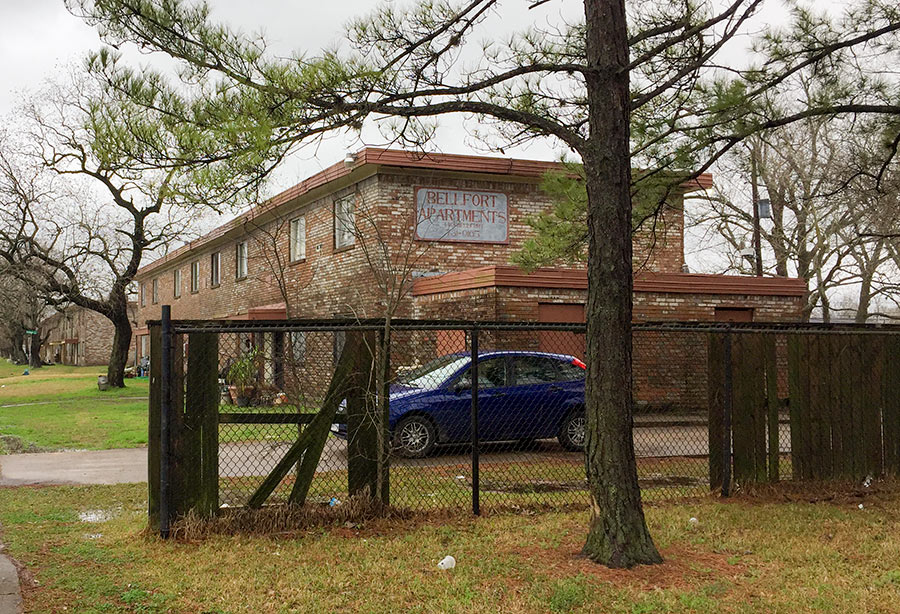SUNNYSIDE PASSED OVER FOR LIST OF HOUSTON PLACES THAT ALWAYS GET PASSED OVER  The Texas Low Income Housing Information Service released a statement right after Mayor Turner’s Monday announcement on the Complete Communities program questioning why Sunnyside didn’t make the cut, Steve Jansen reports this week for the Houston Press.  Despite the neighborhood’s oft-heralded blight resume (it made the LARA team during Mayor White’s time in office, and even got rolled into its very own tax increment reinvestment zone last year, a distinction theoretically reserved for “unproductive, underdeveloped, or blighted” areas), Sunnyside didn’t make the list of the first 5 pilot neighborhoods for the new program, which so far looks like it might shuffle existing development money toward the targeted areas without adding any new cash. The statement, coauthored by a Sunnyside-area civic association leader, notes that the neighborhood even has a ready-to-go redevelopment plan that’s been in the work for the past few years.  [Houston Press; previously on Swamplot] Map of pilot areas for Complete Communities program: City of Houston
The Texas Low Income Housing Information Service released a statement right after Mayor Turner’s Monday announcement on the Complete Communities program questioning why Sunnyside didn’t make the cut, Steve Jansen reports this week for the Houston Press.  Despite the neighborhood’s oft-heralded blight resume (it made the LARA team during Mayor White’s time in office, and even got rolled into its very own tax increment reinvestment zone last year, a distinction theoretically reserved for “unproductive, underdeveloped, or blighted” areas), Sunnyside didn’t make the list of the first 5 pilot neighborhoods for the new program, which so far looks like it might shuffle existing development money toward the targeted areas without adding any new cash. The statement, coauthored by a Sunnyside-area civic association leader, notes that the neighborhood even has a ready-to-go redevelopment plan that’s been in the work for the past few years.  [Houston Press; previously on Swamplot] Map of pilot areas for Complete Communities program: City of Houston





By the same logic, Greenspoint and Westwood didn’t make the cut either. Granted Westwood never seems to make the cut for anything. But one would think Greenspoint would have made it.
The Texas Low Income Housing Information Service has missed the point of this program. The City’s lawyers have indicated to HUD that Houston’s plan is to: “transform previously neglected neighborhoods into neighborhoods HUD would define as ‘high opportunity’.”
.
This means that the City proposes to invest money into blighted neighborhoods that have near-term gentrification potential (i.e. not Sunnyside, not Fifth Ward, not Kashmere, not Fondren SW, et al.) in order to displace non-subsidized poor households out of them and replace those with affluent households. The City will then have grown the number of subsidized poor households located within “high-opportunity” census tracts, allowing them the leeway to continue developing new subsidized housing away from affluent NIMBYs just as they’ve been doing all along.
.
The City is showing utter contempt toward their poor constituents, toward the spirit of the law in these matters, and toward the Supreme Court. And they’re being astoundingly transparent about it.
5th ward was also looked over. Take a drive through that area if you want to see “unproductive, underdeveloped, and blighted” areas. I am surprised to see Northside, 3rd ward, and 2nd ward make the cut. All these areas are going through the gentrification process at a rapid pace. Maybe that is the true reason for the selection of areas.
Well now that you explain it, Niche, it actually makes sense and I agree with what the City’s doing! I’ve said all along that the City of Houston should identify areas where gentrification is imminent, and focus housing efforts in those locations. I guess I was thrown a little because everyone writes off the possibility of Gulfton and Acres Homes gentrifying.
.
I should also note a major mistake on your part. You act as though NIMBYs and the City Government are the enemy to building affordable housing in high opportunity areas. But the real enemies to the construction of new affordable housing in high opportunity areas in Houston are private slum lords (like the Vaknins from Englewood Cliffs New Jersey – who were responsible for the mess at the Crestmont Village Apartments).
.
Middle class neighbors just want to live in neighborhoods that are safe; with schools they feel good sending their kids to. Access to parks, retail, and entertainment is a plus for some; tranquility for others. Ironically it’s the exact same thing poorer tenants who would move into low income housing want. Slum lords like Abraham and Denise Vaknin, on the other hand, are solely interested in profit. They defer maintenance; rent to known criminals; evict mothers and children. The Vaknins took it to the extreme of not paying their utility bills or addressing red tags on blatantly unsafe conditions; and they did it at numerous properties across state lines.
.
Nobody should have to live in those conditions; and it’s perfectly understandable that nobody would want that near them. That’s where NIMBYs come from; and that’s where your battle should be.
.
It’s a shame that so many housing advocates make the same mistake you do.
Low income housing owners can learn a lot from Cleme Manor.
.
Enforce a strict 3 strike policy on troublemakers and people that cant keep the neighborhood clean
Work closely with law enforcement
and help those with financial difficulties
.
If you are a benefit to the community and you have the support of law enforcement, the city will help fund your upgrades.
My guess is that they are choosing to do the projects in neighborhoods that seem pretty sketchy but where success is more or less guaranteed. It’s a savvy move. Trying to do this in Sunnyside or 5th ward would be a massive political risk as it’s a total dice roll if it will actually show any real improvement.
Not to say that any of these neighborhoods are slam dunks either. 3rd ward in particular is still in really really bad shape, as are large sections of Northside. 2nd ward is a little better off, but you wouldn’t think it to look at it (especially the Harrisburg/Canal corridor east of York.
@ ZAW: I’m not sure that I follow. From what you wrote, it seems like you are saying that the Vaknins and other landlords (whom I would sooner describe as grossly incompetent rather than profiteers) have been attempting to block the development of public housing in or near affluent neighborhoods. That doesn’t seem like it makes any sense at all.
Niche: slum lords may or may not be intentionally blocking new affordable housing. But their failure to keep their properties up has left affordable housing with a bad name – and that’s what drives much of the NIMBYs, and by extension the opposition of elected officials. The public conflates these slums with affordable housing. In their view, it’s all “Section 8 Housing,” and they don’t want it anywhere near them.
.
While housing advocates and reputable affordable housing developers and investors provide housing that is far better than slums; they lose in the court of public opinion by not going after the slumlords with the same fervor with which they often attack NIMBYs. I am convinced that if developers and advocates got the reputation of being on the neighborhoods side; of listening to their needs and concerns; and of being vocal against slum lords like the Vaknins: much if not all of the opposition they face to affordable housing, would go away.
It’s more than just that, though. The primary reason I call slum lords the real enemy is that in many cases they actively make life miserable for their tenants. Whether it’s a failure to man guard booths and fix gates – like they have at the Haverstock Hills – or failing to repair unsafe or unsanitary conditions (mold, crumbling ceilings) – or evicting tenants who complain too much about it – or other things that are even more egregious (like the slumlord that confiscated a tenant’s front door when she got behind on her rent; or of course the Vaknins failure to provide tenants with running water) – the slum lords do it because they can get away with it. The people who should be most vocal in standing up for tenants against slum lords are the housing advocates. But they’re too busy railing against NIMBYs to care much.
“This means that the City proposes to invest money into blighted neighborhoods that have near-term gentrification potential (i.e. not Sunnyside, not Fifth Ward, not Kashmere, not Fondren SW, et al.) in order to displace non-subsidized poor households out of them and replace those with affluent households.”
Quit making things up all of the time. WOW
ZAW: I agree with much of what you say. And I don’t know anything about the Vaknins other than they owed Crestmont. And not to defend them but it’s hard to run a complex, and provide repairs, to people NOT paying rent. And make no mistakes about it: Those people were not paying rent. I know because the city convinced me to take 12 of them. And after the free month from the city, NOT ONE paid rent. We had to evict ALL of them. And we gave them a nice clean quite safe property. Half of the units we rented to them got destroyed in the process.
.
So put yourself in Vaknins shoes. What would you do? Do you think he was just sitting back rolling around in a swimming pool of cash from taht property? It was bleeding him dry most likely (I know as I often buy properties from people that tried to make it work then couldn’t)
And ALL investors are interested in profit. From low end slum properties to A+ urban properties. Sure they evict “mothers and children” when they don’t get rent. They have to. And why they hell wouldn’t they? Where do you think the money to MAINTAIN a property comes from? You want onsite guards and gard booths and gates and … That comes with a COST. That cost = higher rent. And many people dont’ want to or can’t pay that higher rent. So there will always be people offering a lower priced option. If people take it, over a nicer place, there is a reason for it. Maybe I have two propeties side by side. One gated and guarded for $600/month and one that’s not for $500/month. You’ll have some people willing to pay the extra $100, and some that are not (or can’t)
.
And “rent to criminals”? While we screen criminals, where do you think they’re supposed to live? They are going to live SOMEWHERE right? So why bag on an apartment complex for renting to them?
.
I know you want these slumlords to put themselves in the shoes of a neighbor by the complex, but you should put yourself in their shoes sometimes. Buying a property in a ‘bad’ area is REALLY hard to run. Finding tenants that pay rent and won’t destroy your place is just one of many challenges.
.
Sorry for the rant but I see so many people railing on ‘slumlords’ that have no idea what they’re talking about or no idea what goes into running a challenging property
@ ZAW: Sorry for the delayed response. I lost track of this post. I would’ve brought up similar points to Cody’s but probably not as eloquently. Most crucially, I agree with him that many of the sort of people that voluntarily rent slummy housing, whom most of the rest of us are willing to pay money to live apart from, aren’t simply going to go away if the City lays harder into the landlords. They’re going to go somewhere. They’re going to be somebody’s headache. And their association with poor communities will forever tarnish the reputation of poor people in general. Moreover, the City of Houston, Houston ISD, et al., are comparably well-equipped to deal with its poor residents’ needs. If the poorest and most troubled people are displaced to the ETJ or smaller municipalities, they and their adoptive communities will be even worse off. It would be even more difficult to tackle social problems or to provide oversight where there is a genuine public health/safety menace.
.
On a related note, this is a good example of an issue where local control is not always for the best and needs to be guided more explicitly by federal or state policy.
.
@TellTheTruthForOnce: Can you tell me with a straight face that this “Complete Communities” program won’t just pile onto the issue of disparate impact (if not outright getting into the realm of disparate treatment)? Come on now. Don’t be naive.